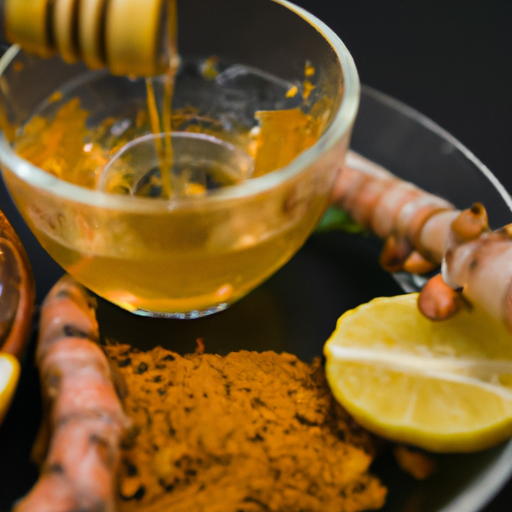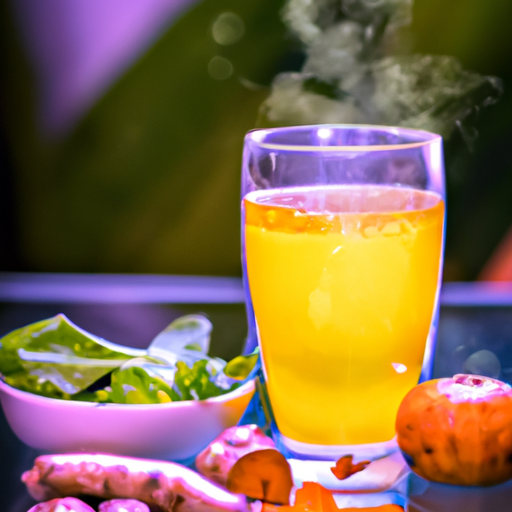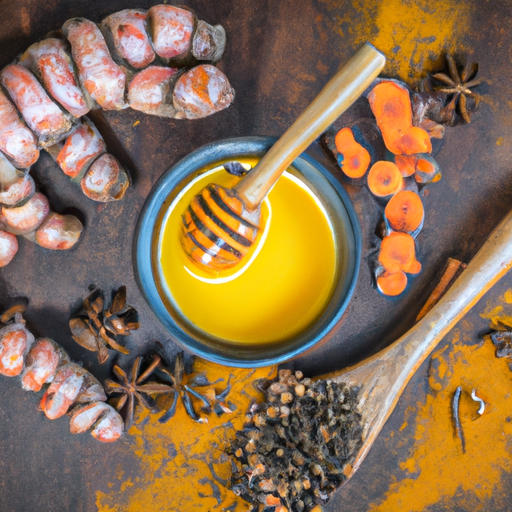Ah, there’s nothing quite like a hot cup of tea to warm you up on a cold day. Turmeric tea makes for an excellent pick if you’re in search of something both nutritious and tasty. It’s not just its deep, robust taste that’s appealing, but also the wide range of health advantages it offers.
As someone who loves exploring natural remedies and alternative medicine, I was excited to discover turmeric tea. This bright yellow spice has been used for thousands of years in Ayurvedic and Chinese medicine to treat various ailments.
From reducing inflammation to improving brain function and lowering the risk of heart disease, the list of potential benefits seems endless. So, if you’re ready to make this superfood part of your daily routine, let’s dive into how to make healthy turmeric tea at home.
Key Takeaways
- Turmeric tea is a healthy beverage option that has been used for thousands of years in Ayurvedic and Chinese medicine.
- Adding black pepper or ginger to turmeric tea can enhance the absorption of curcumin, the antioxidant that provides many health benefits.
- Natural sweeteners like honey or cinnamon can be added to turmeric tea for sweetness, and ginger and cinnamon can also provide additional anti-inflammatory effects and blood sugar regulation, respectively.
- It is important to consume turmeric in moderation and be aware of potential risks and interactions with certain medications.
Understanding the Benefits of Turmeric Tea
If you’re looking for a warm and cozy way to boost your health, turmeric tea is the perfect choice with its golden hue and powerful benefits.
Turmeric has been used in traditional medicine for centuries due to its anti-inflammatory properties, which can help reduce joint pain and inflammation. It also contains curcumin, a compound that acts as an antioxidant and may protect against some chronic diseases.
Turmeric tea recipes abound on the internet, but it’s important to note that not all of them are created equal. For maximum health benefits, look for recipes that include black pepper or ginger as these ingredients can enhance the absorption of curcumin into the body. Some popular variations include adding honey or cinnamon for sweetness.
Now that you understand the many benefits of turmeric tea and have found a recipe you like, it’s time to gather your ingredients.
Gather Ingredients
First, you’ll need to gather all the necessary ingredients for brewing a delicious cup of this golden elixir. Turmeric tea can be made with various ingredient options, but the most basic recipe only requires three: turmeric powder, water, and sweetener of your choice.
However, some people prefer adding other healthy ingredients such as ginger, cinnamon, or honey for added flavor and more health benefits. Turmeric is known for its anti-inflammatory properties that help fight chronic diseases like cancer and diabetes. Additionally, it’s packed with antioxidants which help protect your body from free radicals that cause oxidative stress on cells.
Ginger has also been shown to have anti-inflammatory effects and aid in digestion while cinnamon helps regulate blood sugar levels. Lastly, honey is a natural sweetener high in antioxidants too.
Now that we’ve gathered all our ingredients, let’s move on to preparing the turmeric paste!
Prepare the Turmeric Paste
To get that rich, vibrant hue and potent flavor in your cup, you’ll need to whip up a turmeric paste that’s as bright as the sun. The traditional way of making this paste involves mixing turmeric powder with water or coconut oil until it turns into a thick, smooth consistency.
However, if you don’t have those ingredients on hand, you can also use grated fresh turmeric root or even ground cinnamon for a different twist. One alternative to the classic recipe is adding black pepper to your turmeric paste. This may sound like an unusual combination but studies have shown that piperine – found in black pepper – enhances curcumin absorption by up to 2000%.
Curcumin is the active compound in turmeric responsible for its anti-inflammatory and antioxidant properties. Another idea is incorporating ginger or honey for added health benefits and sweetness respectively. Now that you’ve prepared your desired turmeric paste variation, it’s time to brew the tea!
Without further ado, let me guide you through this simple process.
Brew the Tea
So now that I’ve got my homemade turmeric paste ready, it’s time to brew the tea.
The first step is to boil some water in a pot or kettle.
Once the water’s boiling, I’ll add a spoonful of turmeric paste and stir until it dissolves completely.
If desired, I can also add other ingredients like honey, ginger, or lemon for extra flavor and health benefits.
Boiling Water
Before you can enjoy a warm and soothing cup of turmeric tea, start by bringing water to a boil. The ideal temperature for boiling water is 100°C or 212°F, but if you want your turmeric tea to be extra special, try using filtered or spring water. This will not only improve the taste but also provide additional health benefits.
Boiling water is an essential step in making any type of tea, including turmeric tea. After you’ve reached the right temperature, it’s time to add the turmeric paste and let it simmer for a few minutes. This will help release all the flavors and nutrients from the spice, resulting in a deliciously healthy beverage. Turmeric tea can also help boost your energy levels and immunity.
Adding Turmeric Paste
You can enhance the flavor of your warm cup by adding a spoonful of turmeric paste and letting it simmer for at least five minutes. Uses of turmeric paste aren’t limited to just tea. You can add it to smoothies, soups, or use it as a marinade for meats.
Recipes with turmeric paste include golden milk, curries, and roasted vegetables. Turmeric is known for its anti-inflammatory properties and may aid in digestion. Adding this spice to your daily routine may have numerous health benefits.
Optional additions to your healthy turmeric tea include ginger for an extra boost of anti-inflammatory power or honey for sweetness.
Optional Additions
To spice up your warm cup, consider adding ginger or honey for a touch of extra flavor and health benefits. Ginger has anti-inflammatory properties that can help reduce muscle soreness and improve digestion. It also adds a subtle kick to the tea, making it more enjoyable to drink.
Honey, on the other hand, is a natural sweetener that can help soothe a sore throat and boost the immune system. Other optional additions you could try include cinnamon, cardamom, black pepper, or even coconut milk for a creamier texture.
Cinnamon has been shown to have anti-diabetic effects and may help lower blood sugar levels. Cardamom has been used traditionally in Ayurvedic medicine to treat digestive issues and bad breath. Black pepper contains piperine which enhances curcumin absorption in turmeric. Coconut milk is rich in healthy fats that can help increase satiety and support brain function.
Now that you’ve added your desired ingredients into the pot with your turmeric paste and water mixture, it’s time to let everything simmer for about 5-10 minutes before straining out any solids.
Strain the Tea
Congratulations, you’re finally at the point where you get to strain out all those pesky turmeric chunks and enjoy a smooth cup of tea. Straining the tea is an important step because it removes any remaining bits of turmeric or ginger that could make your drink gritty. To do this, simply pour the mixture through a fine mesh strainer into your mug. If you don’t have a strainer, cheesecloth or a coffee filter will also work.
Now that your tea is ready to be served, let’s talk about some ways to make it even more enjoyable. First off, if you’re worried about removing turmeric stains from clothes or surfaces, don’t worry! While turmeric can be notoriously difficult to remove from fabrics and countertops, drinking it should not result in staining as long as you’re careful while brewing and drinking the tea.
As for serving suggestions, I like to keep things simple by adding a squeeze of lemon juice and honey for sweetness. However, feel free to experiment with other add-ins like cinnamon sticks or black pepper for added flavor. Now that we’ve covered how to strain the tea and some serving suggestions, let’s move on to the next step: sweetening your tea to taste using natural sweeteners like honey or stevia.
Sweeten to Taste
Now that I’ve strained my turmeric tea, it’s time to sweeten it to taste.
When it comes to sweeteners, there are two main options: natural and artificial. Natural sweeteners like honey or maple syrup can add a delicious flavor without the added sugar of processed white sugar. However, if you prefer a zero-calorie option, artificial sweeteners like stevia or Splenda may be more up your alley.
Let’s dive into the pros and cons of each option so we can make an informed decision on how to best enjoy our turmeric tea.
Natural Sweeteners
Using natural sweeteners like honey or maple syrup can add a touch of sweetness to your turmeric tea without compromising its health benefits. Here are three reasons why I prefer using natural sweeteners:
- Better for your body: Unlike artificial sweeteners, natural sweeteners provide essential nutrients and minerals that contribute to overall health.
- Lower glycemic index: Natural sweeteners have a lower impact on blood sugar levels than refined sugars, meaning they cause less of a spike in insulin production.
- Taste better: Let’s be honest, natural sweeteners simply taste better than their artificial counterparts.
While it may be tempting to use artificial sweeteners as a low-calorie alternative, they come with their own set of downsides.
Let’s explore more about the negative effects of using artificial sweeteners in the next section.
Artificial Sweeteners
Artificial sweeteners may seem like a silver bullet for satisfying your sweet tooth, but they are actually a wolf in sheep’s clothing. While they contain few or no calories, studies have shown that consuming artificial sweeteners can lead to weight gain and an increased risk of type 2 diabetes. Additionally, some people experience digestive issues such as bloating and gas after consuming these types of sweeteners.
Table: Pros and Cons of Artificial Sweeteners
| Pros | Cons |
|---|---|
| Few or no calories | May increase risk of type 2 diabetes |
| Do not raise blood sugar levels | May cause digestive issues |
| Widely available and convenient | May negatively impact gut microbiome |
Thankfully, there are alternatives to artificial sweeteners that can still satisfy your cravings without the negative health consequences. Natural sweeteners like honey, maple syrup, and stevia provide a healthier option while still adding sweetness to your turmeric tea. Plus, using natural sweeteners can enhance the flavor profile of your drink by providing subtle hints of their respective flavors.
With these alternative options in mind, you can enjoy hot or cold turmeric tea without sacrificing taste or compromising your health.
Enjoy Hot or Cold
Whether hot or cold, sipping on a cup of this nutritious turmeric tea is a simple and enjoyable way to boost your health. Here are some ways to enjoy it:
- Add honey for sweetness
- Squeeze in some lemon juice for extra Vitamin C
- Sprinkle in some cinnamon for added flavor and antioxidants
- Serve over ice with a sprig of fresh mint
- Garnish with a slice of fresh ginger
Not only does turmeric tea taste great, but it also has numerous health benefits. It contains curcumin, which has anti-inflammatory properties that can help reduce joint pain and inflammation. It also helps improve digestion and boosts the immune system. Plus, turmeric is packed with antioxidants that protect against free radical damage.
To make sure you always have turmeric paste on hand for your tea, here are some tips for storing it:
- Keep it in an airtight container in the refrigerator
- Use within 2 weeks for optimal freshness
- Freeze any extra paste to use later
By following these tips, you can easily incorporate turmeric into your daily routine and reap all its amazing benefits!
Tips for Storing Turmeric Paste
To ensure your turmeric paste stays fresh, it’s important to know how to properly store it in the fridge or freezer. Storing turmeric paste is simple and can extend its shelf life.
After making the paste, let it cool down before storing it in an airtight container.
When storing turmeric paste, keep it in the refrigerator for up to two weeks or freeze it for longer storage. This will help maintain its freshness and flavor. If you’re freezing the paste, make sure to thaw it completely before using.
Properly stored turmeric paste can last for months, but watch out for any signs of spoilage such as mold growth or an off odor. When using your stored turmeric paste, always inspect it first before incorporating into your recipe.
With these simple tips for storing turmeric paste, you can enjoy its health benefits with added convenience and ease.
Moving forward into discussing precautions and risks when consuming turmeric tea, always remember that moderation is key.
Precautions and Risks
It’s important to note that consuming excessive amounts of turmeric can lead to potential risks and side effects, so moderation is key when enjoying its benefits. Here are some precautions and risks you should be aware of:
-
Allergies: Some people may have an allergic reaction to turmeric, especially if they are allergic to plants in the ginger family. Symptoms may include a rash, hives, or difficulty breathing. If you experience any of these symptoms after consuming turmeric, stop using it immediately and seek medical attention.
-
Dosage: While turmeric is generally considered safe in small doses, taking high doses may cause gastrointestinal issues such as nausea, diarrhea, or stomach upset. It’s recommended that adults consume no more than 1-3 grams of turmeric per day.
-
Interactions with medication: Turmeric may interact with certain medications such as blood thinners or diabetes medications. If you’re taking any prescription drugs, talk to your doctor before adding turmeric to your diet.
-
Turmeric supplements: Be cautious when taking turmeric supplements as they’re not regulated by the FDA and may contain harmful additives or incorrect dosages. It’s best to get your daily dose of turmeric from natural sources such as fresh roots or powder added to food or drinks.
By following these precautions and being mindful of dosage and interactions with medication, you can safely enjoy the many health benefits that turmeric has to offer. Remember that moderation’s key when it comes to incorporating new foods into your diet!
Frequently Asked Questions
What are some common side effects of drinking turmeric tea?
As someone who’s been drinking turmeric tea regularly, I’ve experienced some possible side effects like stomach discomfort and diarrhea. However, these side effects aren’t common and can be managed by adjusting the dosage or frequency of consumption.
It’s also important to note that combining turmeric with other herbs like ginger, cinnamon, or black pepper can enhance its health benefits and minimize any potential side effects.
Therefore, if you want to enjoy the many health benefits of turmeric tea while avoiding any negative consequences, consider experimenting with different herb combinations and monitoring your body’s response.
Can turmeric tea be consumed during pregnancy?
Turmeric tea during pregnancy and breastfeeding may pose health risks and safety concerns. While turmeric is generally considered safe when consumed in food amounts, it’s important to exercise caution when consuming it in medicinal amounts or as a supplement. Some studies suggest that high doses of turmeric may stimulate contractions and increase the risk of miscarriage. Others indicate that turmeric may have antioxidant properties that can benefit both mother and baby. It’s always best to consult with a healthcare provider before consuming any herbal remedies or supplements during pregnancy or while breastfeeding to ensure the safety of both mother and child.
How often should one consume turmeric tea to experience its health benefits?
To reap the health benefits of turmeric tea, it’s recommended to consume it regularly. The frequency of consumption varies depending on individual preferences and health conditions. However, many studies suggest that consuming 1-2 cups of turmeric tea per day can have significant health benefits. These benefits include reducing inflammation, improving brain function, and boosting immunity.
There are various recipes and variations available for making turmeric tea to suit one’s taste buds. It can be prepared by adding turmeric powder or fresh grated turmeric root to hot water along with other ingredients like ginger, lemon juice, honey, or black pepper.
Overall, incorporating regular consumption of turmeric tea into your daily routine can provide numerous health benefits.
Can turmeric tea be made with alternative milk options such as almond or coconut milk?
Oh, absolutely. You can enjoy the health benefits of turmeric tea and experiment with alternative milk options. Almond milk or coconut milk are perfect alternatives for those who are lactose intolerant or simply looking for a dairy-free option. They add a delicious nutty flavor to the tea and provide additional nutrients and minerals that complement the benefits of turmeric.
Plus, adding honey not only sweetens the deal but also provides anti-inflammatory properties that work in tandem with turmeric’s healing powers. So, go ahead and try out different variations until you find your perfect cup of healthy goodness!
Are there any specific brands of turmeric that are recommended for making turmeric paste for tea?
When it comes to making turmeric paste for tea, I prefer using organic turmeric. Non-organic turmeric may contain harmful pesticides and chemicals that can affect the quality of the final product.
As for recipe variations, there are many ways to make a delicious cup of turmeric tea. Some popular additions include ginger, honey, cinnamon, or black pepper to enhance the flavor and health benefits.
It’s important to note that when making turmeric paste, some recipes call for adding coconut oil or ghee to increase absorption of curcumin (the active ingredient in turmeric), but this is optional.
Ultimately, finding the right balance of ingredients that works for you is key in creating a tasty and healthy cup of homemade turmeric tea.
Conclusion
Well, there you have it, folks! Making a healthy turmeric tea is easier than you might think. By following these simple steps, you can enjoy all of the amazing health benefits that this golden spice has to offer.
Turmeric tea is like a warm hug for your body – soothing and comforting with every sip. And just like any good hug, it’s important to take care when making it.
Remember to always use high-quality ingredients and follow proper storage techniques to ensure that your turmeric paste stays fresh and potent for as long as possible.
So go ahead – brew yourself a cup of cozy goodness, sit back, and let the healing powers of turmeric do their thing!










